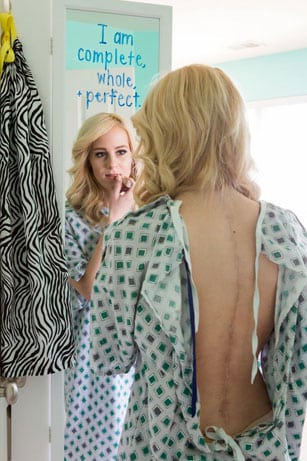
Maryland beauty queen with genetic disorder doesn't hide her scars
Sipping a red sports drink from a straw, smartwatch on her wrist, and curled, shoulder-length hair framing her face, Victoria Graham looks every bit the beauty queen.
But ask her, and she’ll tell you that each accessory has a purpose. Graham wears the watch to help monitor her heart rate; if it dips too low, she is prone to fainting spells. The straw helps her to drink without moving her neck — an imperative because most of her spinal column is fused together. And the hair? Some is a hairpiece she got after a section of her head was shaved during one of her 10 surgeries — operations that left her with a 25-inch scar down the center of her back.
Graham, 23, has Ehlers-Danlos syndrome, a genetic connective tissue disorder that weakens the skin, joints and blood vessels.
“Collagen is like the glue that holds everything in your body together — every cell, every tissue, every organ. Everything,” she said. “And it’s supposed to be a tight and supportive basket weave, but in our bodies it’s falling apart.”
Despite the condition, the resident of Carroll County, Md., was recently crowned Miss Frostburg, the first in a series of pageants she hopes could lead to state and national titles.
And in her quest, she doesn’t hide the scar. In fact, it is showcased.
On Tuesday, Graham will celebrate her first birthday free of hospital gowns in three years. In June she will slip on a gown or two to compete for the title of Miss Maryland.
Her catchphrase at pageants is “But you don’t look sick” when, during the talent segments, she walks onstage in a disposable medical gown sewn loosely and slightly open at the back and delivers a monologue about overcoming obstacles.
“While other girls are singing beautiful songs and they’re in sparkly gowns and elaborate costumes, I’m in a hospital gown with an IV pole,” she said.
Why? “Because that’s who I am.”
Graham was 10 when she fell from gymnastics bars and felt pain in her back that never went away. Specialist after specialist could not understand what was wrong. It took three years and an observant physical therapist to get the diagnosis of Ehlers-Danlos syndrome, also known as EDS.
Headaches came after the back pain. At one point, Graham’s mother, Mary Beth Graham, said she bargained with God: “Give it to me, I’ll take it. Let her feel better.”
Read the whole story at the Washington Post
Victoria Graham, 23, poses in the hospital gown she wears — that shows her 25-inch back scar — during the monologue she delivers as her talent component in pageants. (Allison Shelley/For The Washington Post)

Beauty products sit beside medicine on the dressing table of Victoria Graham. (Allison Shelley/For The Washington Post)
